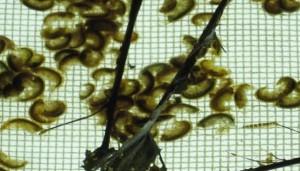In this post, we talk about our recently published paper “The relative importance of diet-related and waterborne effects of copper for a leaf-shredding invertebrate”.
In a recent paper (see the respective post here), we showed that copper exposure positively affects the biomass accrual of leaf-associated fungal decomposers. As leaf-shredders’ nutrition heavily relies on the leaf quality brought about by this group of microorganisms, we hypothesized that the presence of copper during the microbial colonization of leaf material would facilitate the physiological status of shredders when feeding on these leaves over the long term. To test this hypothesis as well as the importance of this diet-related effect pathway compared to waterborne toxicity, we performed a 24-days-lasting bioassay with the crustacean shredder Gammarus fossarum using a 2×2 factorial test design: animals were either subjected to a control treatment, received leaves that were exposed to copper during microbial colonization, were exposed to copper via the water phase, or were subjected to a combination of these effect pathways.
At the environmentally relevant copper concentration applied, waterborne toxicity was negligible, while gammarids fed with leaves exposed to copper during colonization unexpectedly showed a considerably impaired physiological fitness (judged by growth and lipid content). These effects were likely related to the dietary uptake of copper, which we found to accumulate on leaves as well as in gammarids, seemingly overriding the proposed positive nutritional effect of an increased fungal biomass. In consequence, our results suggest that for adsorptive freshwater contaminants dietary exposure may – at least in certain situations – be an even more important effect path in shredders than waterborne toxicity. As the dietary uptake is largely neglected during environmental risk assessment procedures, this factor should be considered in future to safeguard the integrity of detritus-based ecosystems.
The paper was authored by Jochen Zubrod, Dominic Englert, Ricki Rosenfeldt, Jakob Wolfram, Simon Lüderwald, Dennis Wallace, Nadja Schnetzer, Ralf Schulz, and Mirco Bundschuh and published in Environmental Pollution.

